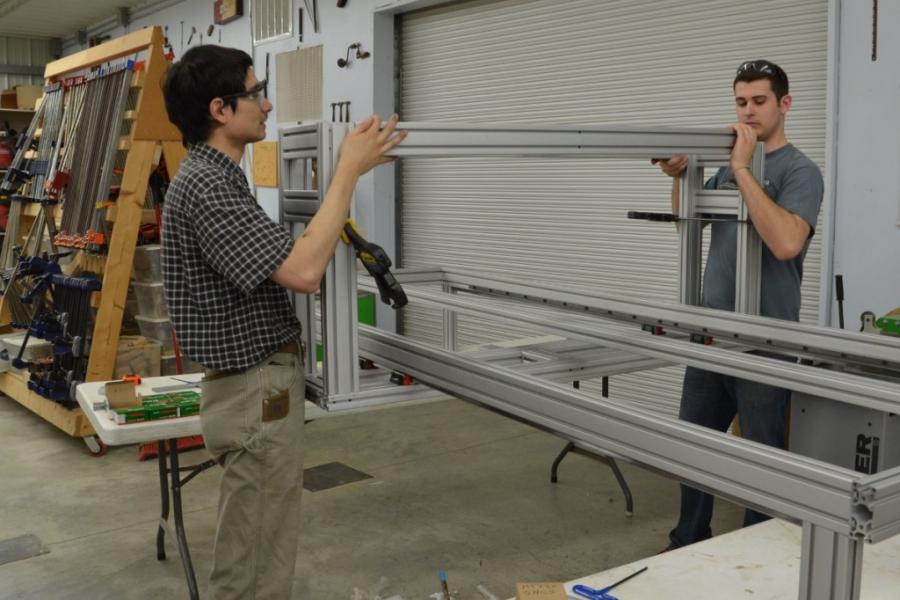5 Strategies for Woodworkers to Beat the Robot Apocalypse
Man Vs Machine
A short story in the style of O’Henry
by
Jacob A. Aune
It was a dark and stormy night. Carl huddled under his hefty roubo bench anxiously looking across the dim shop. A heavy, oak door shuddered from repeated blows. The sound of the impacts intermingled with crashing thunder. He knew his time was short but what could he – a mere man – do against such an invasion?
With the sickening sound of splinters, the wood cracked apart and the sorry wreck of a door skidded across the floor. The once perfect mortise and tenon joinery lay exposed and Carl cast it a rueful glance. He still recalled the pleasant mornings spent shaving the tenons with razor-sharp planes and sliding them home into their receiving pockets. Another crash forced his mind back to the present. This was no time for reminiscing. Those days would never come again. It was time to face the present and as he looked up, the present was ominous indeed.
A massive machine of iron and steel slid through the door frame. He could spot another coming up behind it and another and… Just how many are there, he wondered silently?
Six machines in all. Every one of them a gleaming 4,000 pound beast with menacing gantries that swept back and forth with formidable speed. Dozens of servos hummed and whirred in unison as the terrible array settled into formation around him. Yes, this was the end.
All at once, the monsters fired up their 20HP spindles. The roar of a dozen vacuum pumps filled his ears. With astonishing swiftness, the gantries whipped around, the spindles zipped to and fro and the noise rose to a high-pitched scream as carbide cutters tore through sheets of plywood and mdf. Almost as quick as the eye blinks, perfectly-formed tables and chairs were ejected left and right. Within minutes, the inventory began stacking to the roof and Carl, with a sigh, glanced at the half-finished dining table near his workbench. He’d been lavishing care upon it for the past week.
Carl stood up and tipped his table over in one motion. Twenty paces brought him outside his building. He glanced back into the shop before his attention was caught by a faded sign hanging beside the shattered door frame. Before turning away, he reached up and flipped the sign over.
The sign read, “closed”.
– The End
Or is it?
On September 17th, Carl Frey and Michael Osborne released a report many will view with apprehension – 47% of U.S. jobs could be replaced by automation within two decades.
A visit to various woodworking sites and blogs will uncover much commetary regarding the threat of computerized tools to the livelihoods of contemporary woodworkers. The fact that these conversations are often heated indicates just how much uneasiness exists about the situtation. The vision of a distopian universe where international corporations control all production with their robotic armies and leave half of today’s workers unemployed is unsettling to say the least.
But must it happen that way? Consider the opportunites.
As fewer people are needed to produce necessities, more manpower and money will be freed to put towards luxury items. CNC routers and other computerized equipment will bring the cost of custom woodwork down and make it more acceptable to the pocketbooks of middle-class consumers.
“But,” says the apprehensive mind, “if half the people are unemployed and one percent own all the robots, who will have money to buy these things?
Perhaps nobody? We could also proactively prevent that from happening.
1. If you can’t beat them, join them.
Before the machines come to claim our jobs, and all capital is consumed by mega-corporations, woodworking professionals should consider acquiring this technology for their own use. People can buy necessities for cheap from the billion-dollar, automated factories, then purchase their luxury goods from the small woodshop with the $10,000 CNC router.
Think using computers will destroy the purity of the craft? Hardly. As explained with detail in another post about Handcrafted Furniture, the critical aspect of custom furniture comes from its unique character and not so much the tools used to create it. The tools should be made to fit the design and not the other way around. this preserves the purity of the object.
2. Sell services, not products.
The Frey and Osborne report did mention that occupations requiring significant creative intelligence are unlikely to be replaced by machinery anytime soon. This plays in favor of those who sell a service and not a product. Consider which of the following two woodworkers will still be in business twenty years from now.
“We sell tables. Ikea sells them too but we make ours better for only ten times the price our competitors offer.”
“We don’t sell furniture, we sell a service. We consult, design and personally work with our clientele to create goods specifically suited to their needs and lifestyle.”
A good mantra for the aspiring survivor of the robot apocalypse could be, “Stay nimble, be creative.”
 3. Hold out for retirement or put those computer skills to use.
3. Hold out for retirement or put those computer skills to use.
It is possible older generations can sneak safely into retirement so this is more of a concern for the younger up-and-coming professionals. Luckily these are the people that are most likely to have the necessary computer skills. Would be a crying shame if all that were wasted on idle social media chit chat.
4. Diversify.
The combination of affordable CNC, lasers, modeling software, 3d-scanners and traditional woodworking skills is powerful. Add the marketing potential of the internet and nearly endless possibilities open up to those with the right skills. Knowledge about photography, image and video editing, website building, search engine optimization, internet marketing, 3d modeling and computer-aided machining may be critical for running a successful woodshop in the future.
A small team with the right skills can create a high quality product at higher volume and distribute it to more people than ever before.
Those pondering a woodworking business today should consider adding these skills to their portfolio or teaming up with others that have them.
5. Shift focus away from fading careers and look for emerging opportunities.
I do believe the landscape for the woodworker is changing. Early pioneers like Sam Maloof (Don’t know who he is? Be ashamed! …then click this helpful link) helped resurrect the idea of old-world craftsmanship and proved that despite the difficulties, it could be a viable way to earn a living. With the advent of computers, I see even more potential than the past few decades had to offer – for those who wish to take the leap.
Of course, simply keeping woodworking as a fun hobby is always an option. In that case, throw caution to the wind and work entirely with hand tools if so desired! Regardless of the route traveled, stay nimble and be creative.
Sources:
“The Future of Employment: How Susceptible are Jobs to Computerisation?”
– Carl Benedikt Frey and Michael A. Osborne
Background photo credit from furnitureproduction.net


